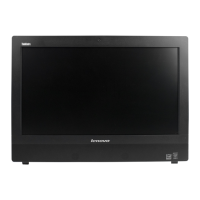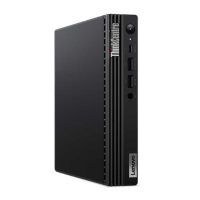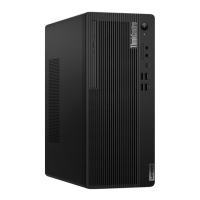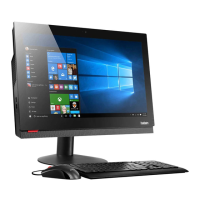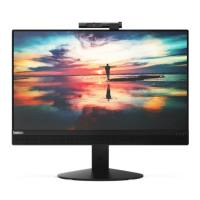Do you have a question about the Lenovo ThinkCentre M81 7518 and is the answer not in the manual?
Guidelines to prevent damage from static electricity when handling components.
Precautions to ensure proper airflow and prevent overheating.
Optimal conditions for computer operation.
Overview of computer features including microprocessors and memory.
Details on optical drives and SATA hard disk drives.
Physical dimensions, weight, environmental operating conditions, and electrical input.
Guides users to information sources and tools for easier and secure work.
Provides access to information and tools for setting up, understanding, and maintaining the computer.
Helps maintain the computer, improve security, diagnose problems, and learn about Lenovo technologies.
Enables restoring the hard disk drive to factory default settings.
Protects information and guards against unauthorized access.
Offers one-button recovery and restore solutions for diagnosing and recovering from system issues.
Helps keep computer software up-to-date by downloading and installing packages.
Information to locate connectors, parts on the system board, and internal drives.
Identifies front panel connectors, controls, and indicators with a diagram.
Identifies rear panel connectors with a diagram and descriptions.
Identifies internal computer components with a diagram.
Identifies various parts and connectors on the system board with a diagram.
Identifies locations of optical drive and hard disk drive bays.
Importance of ergonomics and healthy work habits for computer use.
Guidelines for finding a comfortable sitting position and keyboard use.
Overview of available security features like Computrace, cover presence switch, fingerprint reader, and TPM.
Types of BIOS passwords (Power-On, Administrator, Hard Disk).
Using passwords for Windows login, resource access, and user settings.
Features of the Security Chip and Client Security Solution program.
Options for activating, deactivating, or clearing the Security Chip via Setup Utility.
Using antivirus software to guard against, detect, and eliminate viruses.
Precautions to prevent static-electricity damage when handling computer parts.
General instructions for expanding computer capabilities by installing or replacing hardware.
Step-by-step instructions for opening the computer case.
Steps to access system board components and drives after opening the cover.
Instructions for installing or replacing DDR3 UDIMMs in memory slots.
Instructions for installing or replacing PCI cards in available slots.
Instructions for installing or replacing the computer's card reader.
Steps to remove and install a new card reader.
Instructions for replacing the computer's CMOS battery.
Step-by-step instructions for replacing the computer's hard disk drive.
Instructions for replacing the computer's optical drive.
Instructions for replacing the heat sink and fan assembly.
Instructions for replacing the computer's power supply unit.
Instructions for replacing the computer's microprocessor.
Instructions for replacing the internal speaker, if available.
Instructions for replacing the front audio and USB assembly.
Instructions for replacing the computer's keyboard or mouse.
Final steps after replacing parts, including closing the cover and reconnecting cables.
How to create and use recovery media for system restoration.
Using Rescue and Recovery for backups and restores.
Accessing the workspace for recovery operations even without the OS.
Procedures for reinstalling applications and device drivers.
Setting passwords to protect computer and data access.
Setting a password required at startup.
Setting a password to change configuration settings.
Setting a password to protect data on the hard disk drive.
Procedures for managing passwords via the Setup Utility.
Instructions for updating the BIOS using a bootable disc.
Instructions for updating the BIOS from within the operating system.
Procedure to recover from a failed POST/BIOS update.
How to create and use rescue media for recovery.
Information on keeping the computer in top working order.
Common computer problems and verification steps.
A systematic approach to diagnosing and resolving computer problems.
Symptoms and actions for input device issues.
Symptoms and actions for monitor-related issues.
Common networking issues like Ethernet and wireless LAN problems.
Symptoms and actions for Ethernet connection issues.
Common causes for poor performance and system lockups.
Using diagnostic programs to test hardware and settings.
Using the Toolbox for diagnostics, security, and system information.
Procedures for contacting Customer Support Center for help and information during warranty.
| Operating System | Windows 7 Professional |
|---|---|
| Memory Max | 16 GB |
| Optical Drive | DVD-RW |
| Ethernet | Gigabit Ethernet |
| Processor | Intel Core i5-2400 |
| RAM | 4 GB DDR3 |
| Storage | 500 GB HDD |
| Graphics | Integrated Intel HD Graphics |
| Chipset | Intel Q65 Express Chipset |
| Storage Options | HDD, SSD |
| Audio | High Definition Audio |
| Ports Front | 2 x USB 2.0, Headphone, Microphone |
| Ports Rear | VGA, DisplayPort, Ethernet |
| Power Supply | 240W |
| USB Ports | 8 |
| Form Factor | Tower |



